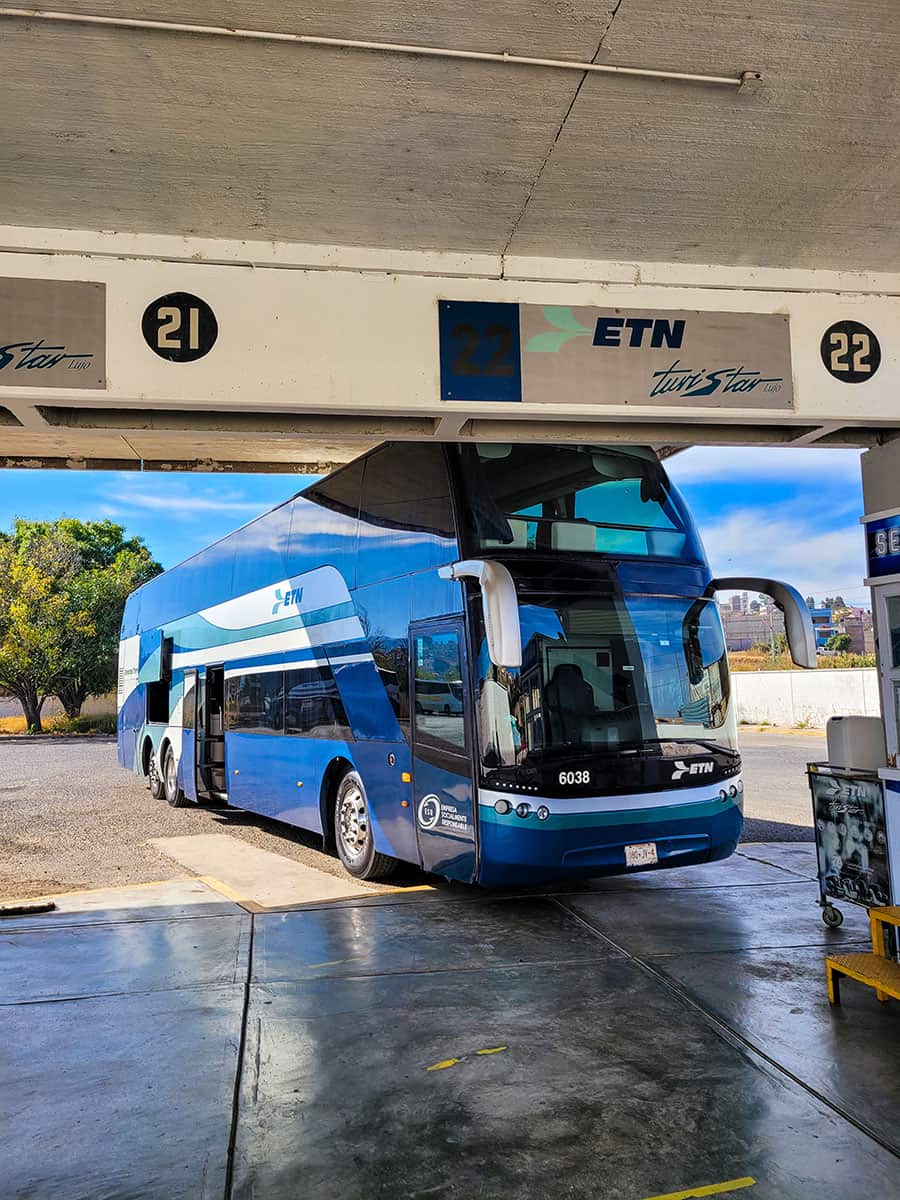Ultimate Mexico Bus Travel Guide 2025

Wondering what it’s really like to travel by bus in Mexico?
Mexico is a big country and if you plan on leaving the tourist trail at all you’re going to be faced with an age old predicament: “That place looks amazing! But how do I get there?”.
Unless you’re planning on driving yourself around the country, there’s a good chance your travels around Mexico are going to require a bus or two.
I love to travel by bus in Mexico but it can be a daunting if you’re not sure what to expect, how it works, or if your Spanish needs improvement.
This guide will cover everything you need to know to confidently and safely explore Mexico by bus, like a pro.
Mexico Bus Travel
In many other countries, buses don’t always have the best reputation and usually aren’t a traveller’s first choice when it comes to getting around. But in Mexico, buses are the way of the people and the experience will likely surprise you.
Many other countries rely on train travel as a comfortable way to travel long distances and that used to be the case in Mexico. Since the 1800’s, passenger trains were the main way to get from place to place and beautiful, old-fashioned train stations known as ferrocarriles can still be found across the country as a reminder.
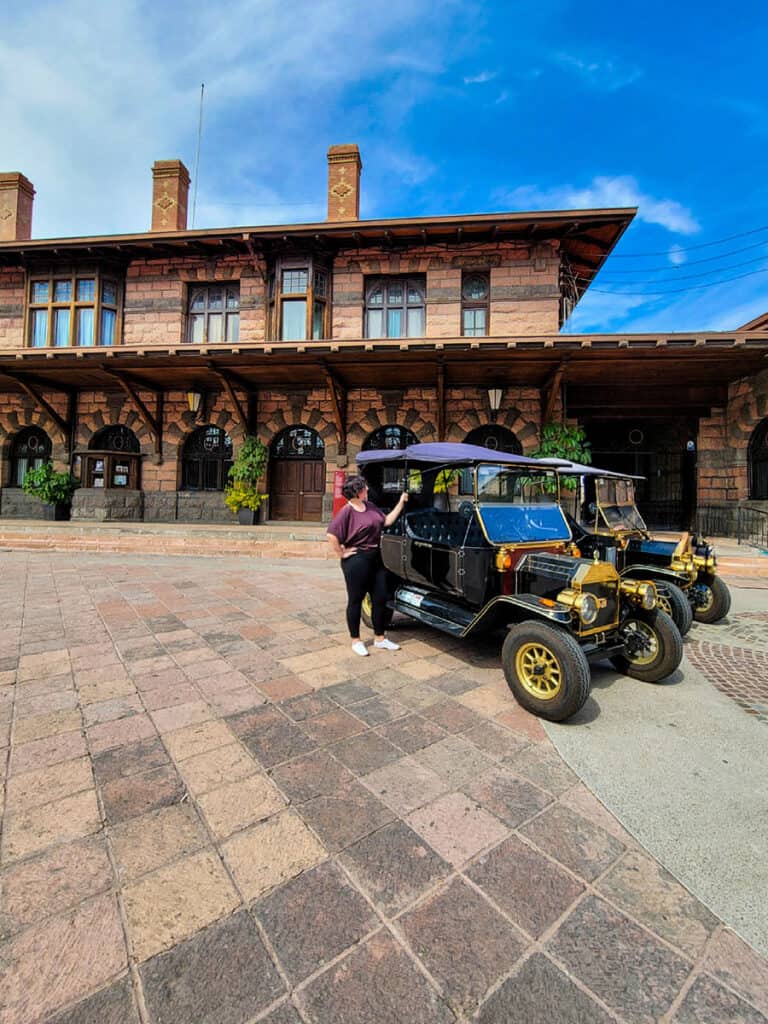
After the Mexican Revolution (1910 – 1920) the train system was underfunded and eventually passenger trains stopped running at all. The national train system was privatized and much of it was sold to US companies who now use the existing infrastructure for freight trains.
Enter, the humble bus.
Bus travel in Mexico is a must for anyone who doesn’t have an unlimited budget for private drivers or a vehicle of their own. Luckily, Mexico has one of the most extensive and affordable bus networks in the world but it can be confusing to navigate.
The standard of bus can range from rickety motion-sickness machines to incredible first-class coaches bursting with amenities. And similarly, bus stations can range from the side of a road to what resembles a modern multi-wing airport.
I know what it’s like to be intimidated by the prospect of bus travel in Mexico and now that I’m a regular passenger, my only regret is not doing it sooner.
This guide will teach you how to navigate the system, find the service that works best for you, and get you safely from A to B while enjoying the experience.
Choosing Your Bus Company
Knowing which bus company to choose in Mexico is important. Unless you’re a seriously budget-conscious traveller you’re probably going to want to opt for a first class bus so it’s key that you know which companies offer this experience.
It’s also important that you understand that there are different levels of service within the first class bus arena and I’ll cover those in the next section.
If you do happen to be one of the super budget travellers who doesn’t want to spare the extra few bucks for first class, I’ve covered your options below.
Executive & First Class Bus Companies
First class buses are the creme de la creme of bus travel in Mexico and executive class buses are the cherry on top. These are the buses travel dreams are made of.
I was absolutely floored by the quality the first time I took one of these buses in Mexico and shocked at how inexpensive this experience was.
Bus companies in Mexico are generally organized regionally and are not all available everywhere in the country. Check out my list of bus companies operating first class buses in Mexico below:
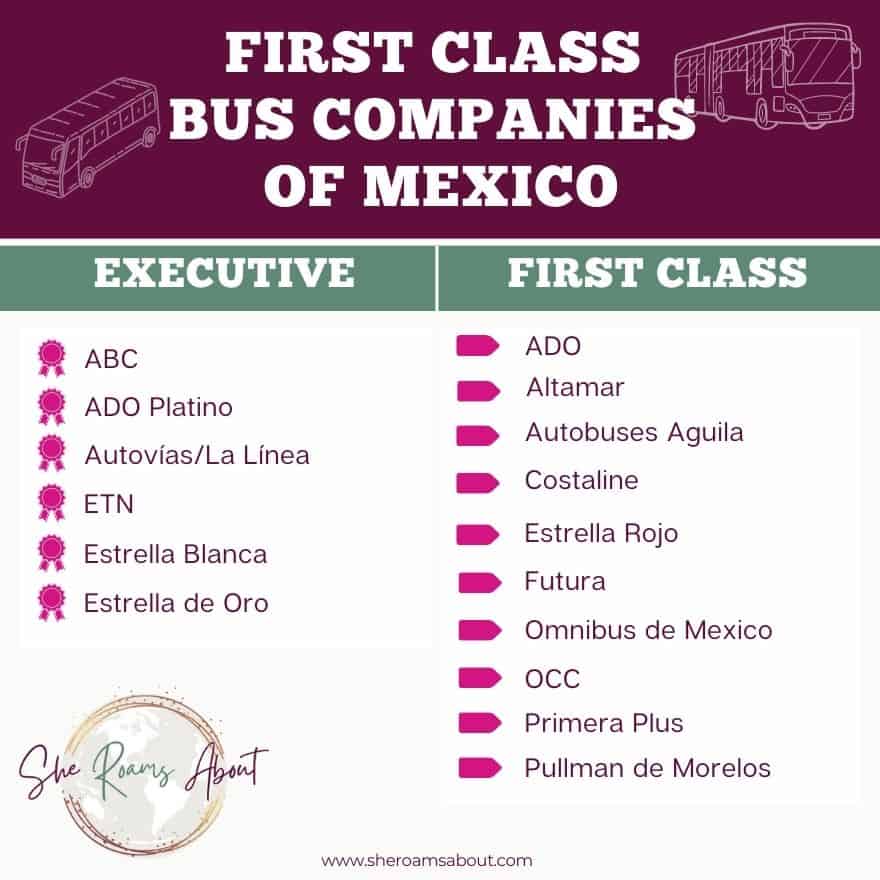
My personal first choice for bus service in Mexico is ETN (pronounced EH-TEH-ENEY). They offer top of the line buses and service and I’ve only had excellent experiences with them.
Another great choice is ADO (pronounced AH-DAY-OH). ADO has been in the business since the 1950’s and has the largest bus network in all of Mexico, operating mostly from Mexico City heading south. ADO also owns many of their own stations and are a well-trusted name in the bus business.
The experience with ETN and ADO tends to be very consistent and reliable making them a favourite amongst Mexicans and visitors.
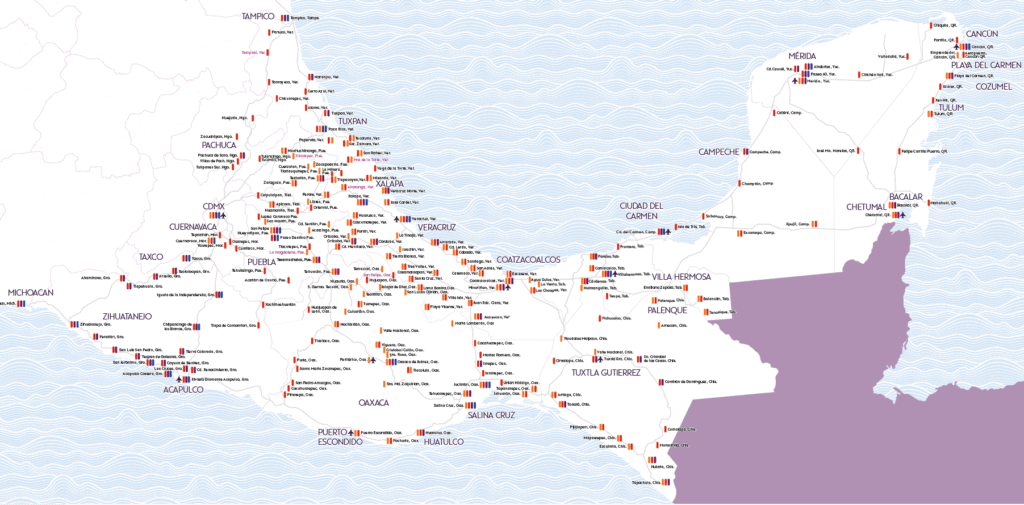
Second Class Bus Companies
If you’re very budget conscious you may prefer to save a few bucks by going the second class bus route. Most second class bus services in Mexico tend to be localized to specific areas but I did want to highlight a common one that you may see come up.
AV and Cristobal Colon are owned by ADO and they are second class services, also known as económico or “economy”. When you are looking for ADO buses in Mexico you may come across these names and it’s important to note that they are not first class buses.
Choosing Your Bus Service
Buses in Mexico come in a few different service levels which I like to break down into second class and first class and above.
Unless you have a seriously tight budget, I recommend that everyone visiting Mexico opt for first class buses or higher (when possible).
First Class & Above
The quality of service on first buses in Mexico varies company by company but the bottom line standard remains roughly the same.
With some of the smaller regional companies the buses will likely be older, and top of the line companies like ETN and ADO run a newer, more polished fleet. Wherever they fall on the scale, first class buses are always the best value for money in my opinion.
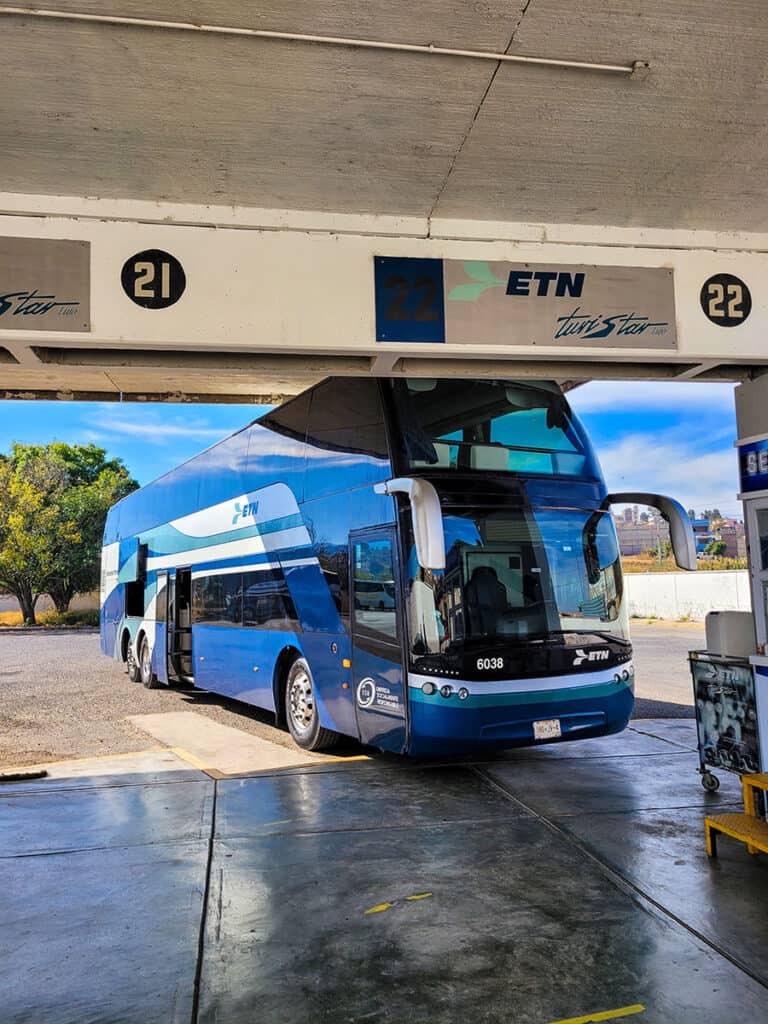
The cost to upgrade from second class would be considered fairly negligible to most people and the difference in service is notable as first class buses are safer, faster, and more comfortable.
First class buses are also the most direct bus services to get from point to point in Mexico. This is important for two main reasons:
1. Fewer stops mean faster travel.
2. Buses that only stop at official stations or don’t stop at all are significantly safer.
In terms of comfort first class buses also have a lot to offer. At a minimum first class buses feature:
If you decide to take it one step further and opt for a luxury or executive class bus, in addition to the above you can also enjoy amenities such as:
Many of the bus company websites have a page that will show examples of their fleet and what to expect from each service. You can find these on their individual websites, usually on pages marked Servicios “services” or Marcas “brands”.
As ADO has the largest network of buses, I’ve included a pocket cheatsheet of each of their service levels below for you to screenshot or save for later.
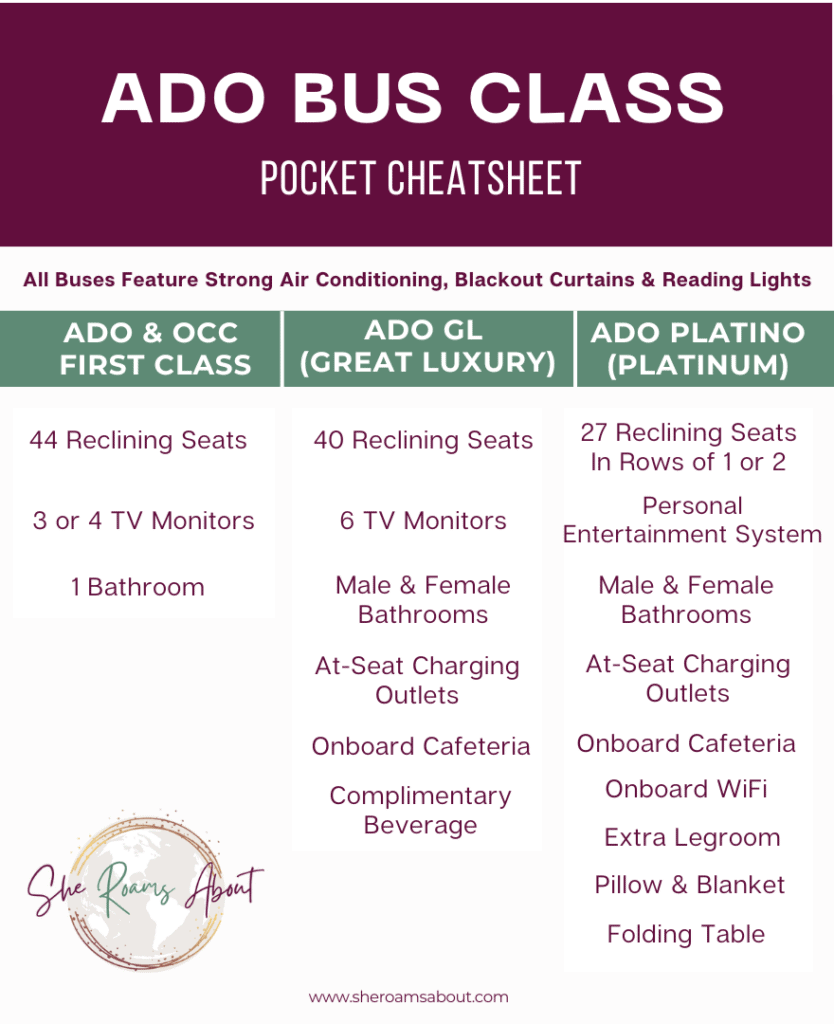
Second Class
Second class buses in Mexico are definitely not of the same standard as first class and what you actually get is luck of the draw.
While they are cheaper than first class buses they usually don’t offer much of a savings and the value for money is much lower which is why I always recommend springing for first class.
Just so you have the full picture, here are a few things you should expect to find on second class buses in Mexico, should you choose this option:
Sometimes taking a second class bus is unavoidable in Mexico but if you have the option, especially on journeys longer than an hour, you should take the opportunity to upgrade to first class or higher.
If you do have to take a second class bus aim for the most direct option possible. ADO offers second class services called AV and Cristobal Colon which they call directo economico “direct economy”. This means they make a lot fewer stops which is a very important feature.
Not only do fewer stops mean a faster journey, they also mean a safer one. If you’ve ever heard about robberies on buses in Mexico, this is usually in reference to second class services.
Buses that stop along the road to pick up passengers should always be avoided, especially when travelling long distances or across state lines.
These passengers are able to board without security checks and while not everyone is dangerous, this is a common way for people to rob bus passengers.
The bus will stop somewhere very rural and someone or a team will board the bus and take all the phones, valuables and money from everyone on board.
An easy way to mitigate this potential danger is to choose direct bus routes that only make scheduled stops at official stations. In other words, choose a first class bus!
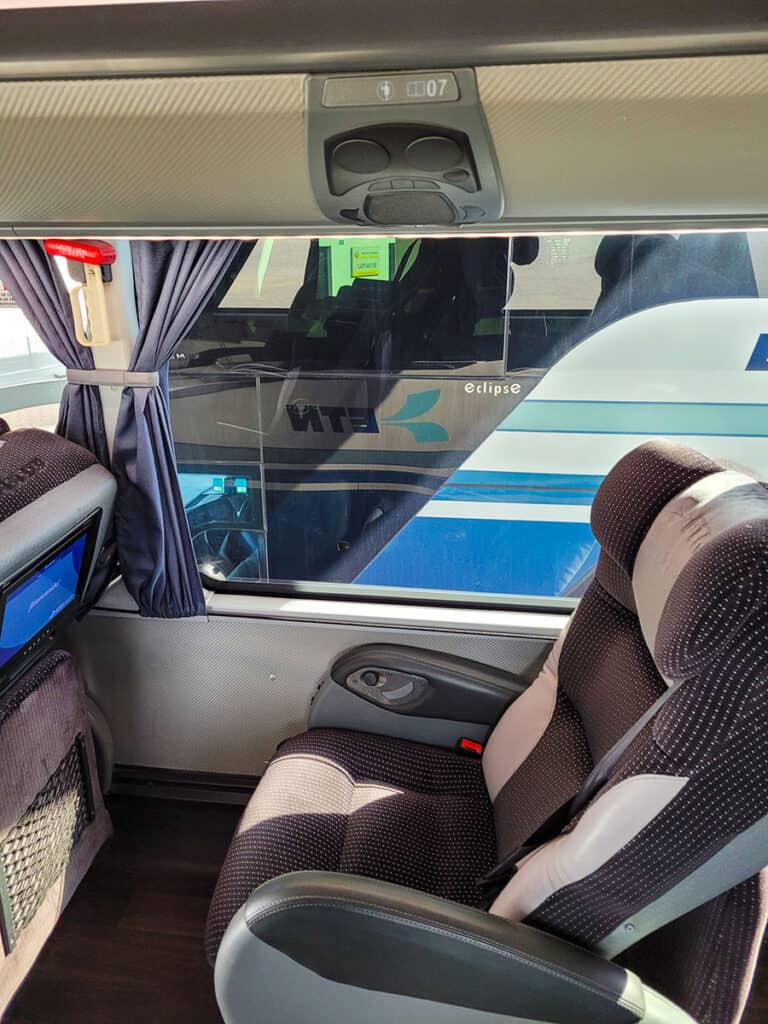
Choosing Your Bus Station
The most important thing to consider when choosing your bus station in Mexico is that you’re actually looking at the right one!
All too often, people will show up at a bus station for their bus and realize they’re in the wrong place and we don’t want that to be you.
The first thing you need to understand is that there may be multiple bus stations in any given area of Mexico. Even small towns may have two or three bus stations!
Generally speaking, second class buses in Mexico will depart from a separate bus station. These stations are normally smaller and more basic, often in less central locations.

First class buses usually depart from the central bus stations and if you’re travelling with ADO, they often have their own branded bus stations.
Pay close attention to the names of the stations. When you enter the location name into a booking website it will show you buses for that whole location. In the case of Mexico City, this means you could get results for four different bus terminals.
I always recommend Googling the bus station options that are presented to you to see how convenient they are for you before choosing. You may see a bus that has great timing but it drops you off at the airport, 40 minutes from your hotel.
Work smarter, not harder!
Facilities At Bus Stations
Bus stations in Mexico can range from a small shelter on the side of the road to something that closer resembles an airport.
Buses are the most popular way for people to travel around Mexico so it makes sense that many of the bus stations would be built to handle volume. I was recently at Querétaro bus station and it was enormous and made up of 4 large buildings.
Here’s an idea of the sort of facilities and amenities you may find at bus stations in Mexico:
Every bus station is different and they will not all offer everything listed above. At the very least you’ll get ticket vendors, a waiting room and a washroom.
Authorized Taxis
Many bus stations in Mexico offer an authorized taxi service similar to what you’d see at an airport. This is great because prices are usually listed and set by travel zone which means you don’t have to worry about negotiating a price.
When you arrive at the station take a look around for taxi or authorized taxi signs.
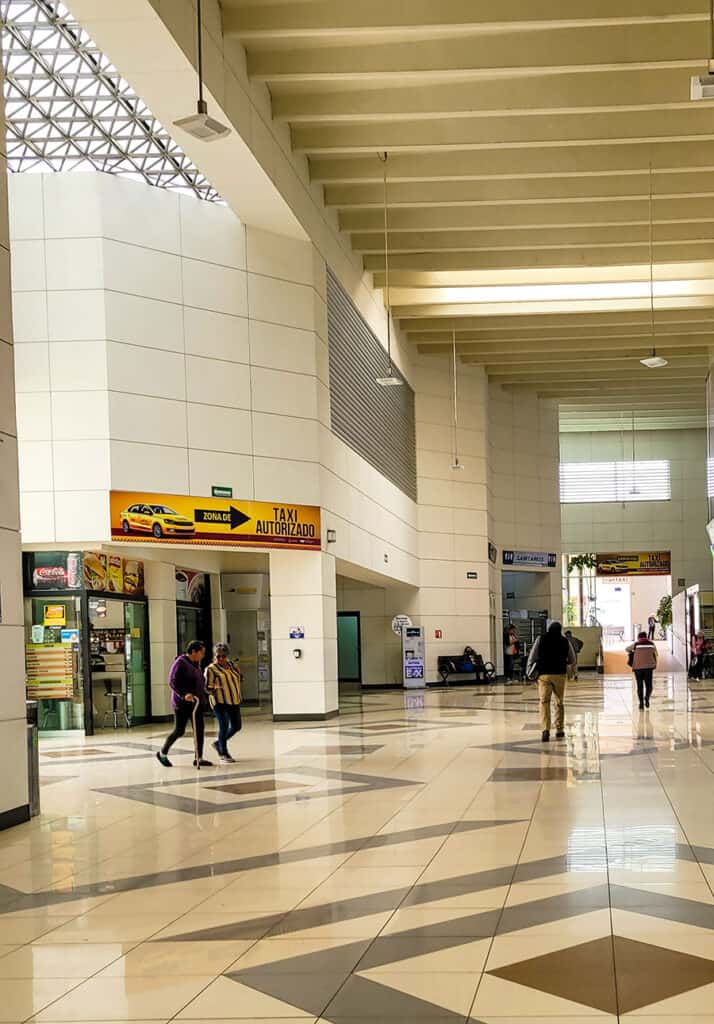
With authorized taxis the system is set up so that you purchase your ticket from a vendor and you provide that ticket to the driver. This way you don’t have to deal with the driver directly when it comes to payment (unless you want to tip).
Depending on the size of the station, there may be one authorized taxi vendor or several. If there are a few in a row then feel free to shop around but the prices are likely to be pretty close, if not the same.
Once you purchase your ticket, the vendor will point you in the direction of the taxi stand. There will likely be an attendant there who is managing the line. You can join the line and when it’s your turn they’ll ask you where you’re going. You can tell them, or show them if you have the address written or printed out.
The attendant will pass this information to the driver, you’ll hand over your pre-purchased ticket and hop into the taxi.
Airplane vs Bus
Generally speaking, bus travel in Mexico is the cheapest way to get around but there are a few instances in which taking a domestic flight is around the same price (or slightly more expensive) but much faster.
A good example of this is the very popular journey of Mexico City to Oaxaca. Many people look at a map of Mexico and think Mexico City to Oaxaca isn’t very far, so they will automatically think a bus is the best choice. What they don’t account for is that Mexico is a very long country and Oaxaca is in the mountains.
When I made the journey from Mexico City to Oaxaca I looked at both buses and airlines and ultimately decided to fly.
The cost of the bus from Mexico City to Oaxaca depends on the level of service you choose but generally this runs $700MXN [$35USD/$48CAD] for a regular first class bus to $1,200MXN [$60USD/$85CAD] for the top tier ADO Platino service.
The bus journey takes about 7 hours but can take a few hours longer due to construction and travel delays.
Flights for this route typically cost under $1,800MXN [$90USD/$120CAD] and take 1 hour 15 minutes. There are multiple flights per day operated by various air carriers, so there are plenty of options to choose from.
Buying Tickets & Making Reservations
Buying bus tickets in Mexico can be very straight forward, or it can come with a few hoops to jump through.
If you’re anything like me you like to have your travel logistics worked out at least a little in advance. My days of blindly showing up at a bus station asking where and when the next bus goes are behind me!
When it comes to buying bus tickets in Mexico you have three main options. You can purchase in advance directly from the operator, purchase in advance using an English language retailer, or purchase at the station on the day.
In Advance Directly From The Operator
The cheapest way to book bus tickets in Mexico is directly from the operator on their website. Cheapest sounds great right? But you may run into some issues.
The quality of website varies company by company and some bus companies don’t have a booking website at all.
It’s a good idea to explore all your bus options on an English-language retailer like BusBud first to help you figure out which company offers the service, route and timing you’re looking for, then head directly to their website to purchase directly.
ETN is a good example of a great website. They have an excellent English-language site and offer discounts for booking tickets in advance. Simply enter your origin point and destination, along with the date you want to travel and click Search.
The results will show you all of your bus options along with some important information.
In addition to the departure and arrivals times, the most important information you can see here is the number of seats that are remaining on each departure and whether it is Local or Transit. Here’s how to read the ETN bus options:

ADO has the largest bus network in Mexico but doesn’t have an English language website and it doesn’t cooperate well with Google Translate. So here’s how to read the booking screen on ADO:

Once you select which bus you’d like to take, the next screen will show you a seat map. Here you can select seats for as many passengers as you’re booking for.
Once you’ve selected your seats you can move to the next screen to complete passenger information.

On the passenger information page make sure you enter your information as it appears on your ID. I’ve translated the ADO booking screen for you below:
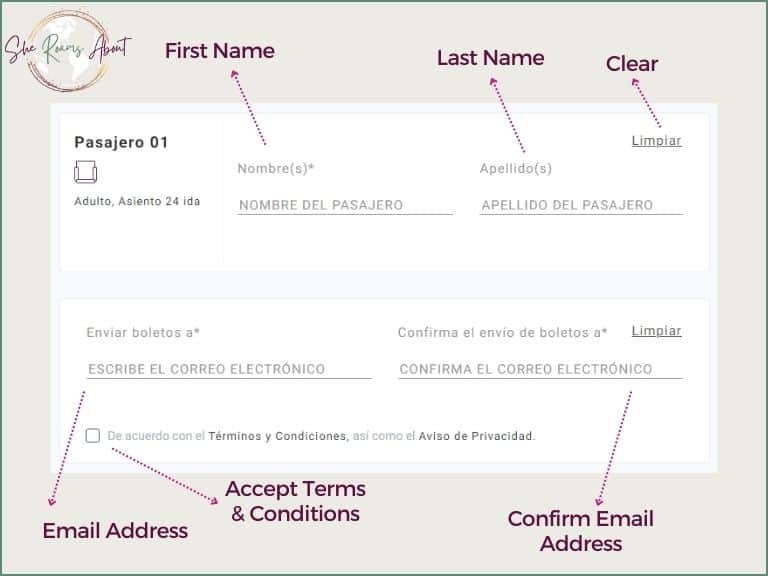
Now you’re at the payment stage and this is often where people run into problems.
Depending on the company you are booking through you may have up to three payment methods available to you:
Paying by credit card and PayPal are fairly self-explanatory. Simply enter your details and you should be good to go.
But recently there have been a lot of reports of foreign credit cards being denied by Mexican bus company websites and this is due to a huge influx of chargebacks they are facing.
If this happens to you, you may want to choose the Cash/In Store option. With this option you’ll be sent a code and a list of well-known stores like OXXO or Soriana. You will need to take your code to the store and pay them to get your tickets.
Your other option is to purchase your tickets online using an English-language retailer like BusBud, which you can read more about in the next section.
In Advance Using An English-Language Retailer
There are a few reasons why you might want to purchase bus tickets in Mexico through a retailer rather than directly from the operator but here are the most common:
If you find yourself in any of these situations or if you are looking for a bus search engine to help you plan your route I recommend you opt for BusBud.
BusBud is the world’s largest bus booking website. Simply enter where you’re starting, where you’re headed, and on what date. Then they will present to you all your bus options for that day.

You’ll be able to easily see which bus companies run this route, the different departure times, duration of the journey, which stations are used, and the price. They’ll even show you connecting bus options and options that involve multiple operators.
For a little more information on a particular journey you can click through to the next page. This will show you the amenities on this journey, if there is any flexibility in the ticket, boarding requirements, and luggage inclusions.
Tickets on BusBud do cost a little more than if you purchase directly but sometimes it’s worth the premium. While some companies like ETN have excellent English websites other companies like ADO don’t have an English site at all and Google Translate struggles with the format of their site.
And while I haven’t had any issues, recently I’ve heard from many travellers that companies like ETN are blocking US credit card purchases.
If you find yourself in these situations it’s good to know you’ve got a reliable backup plan. It’s also just a handy tool to do some research into which buses are available for your planned route.
At The Station On The Day
Sometimes it’s not possible to purchase your bus ticket in advance or maybe you opted not to. In this case, you’re going to need to purchase a ticket at the station on the day.
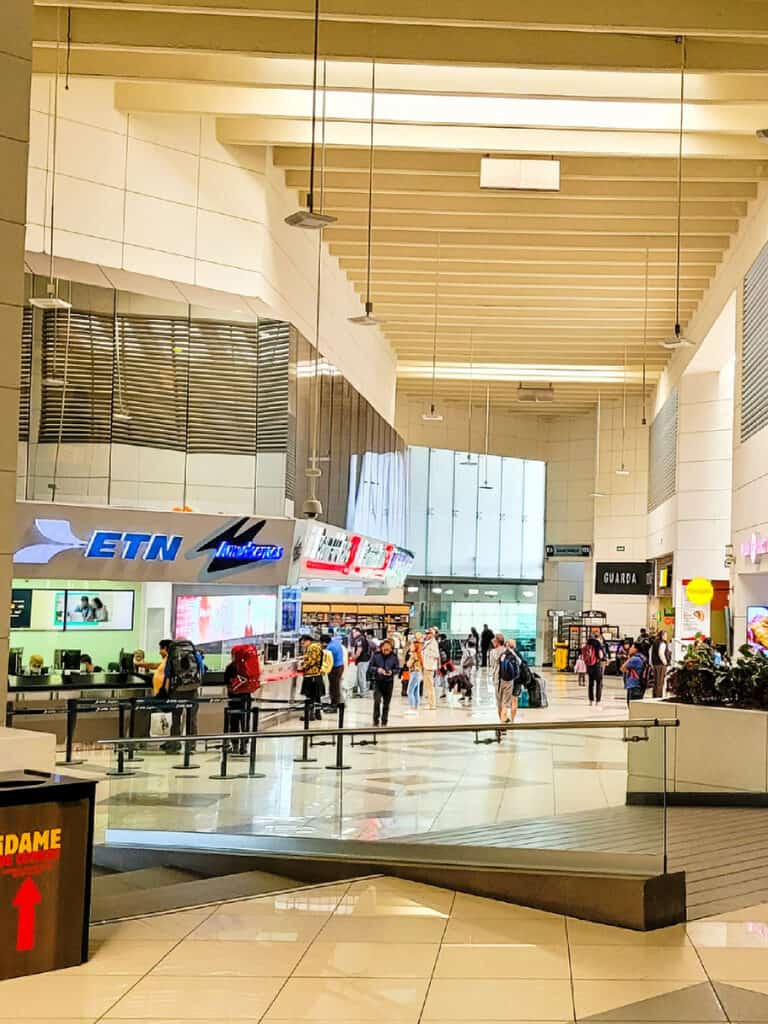
How this works varies depending on the station you’re departing from and/or the bus service you have selected.
Should You Get The Insurance?
Most bus companies in Mexico will offer optional insurance or assistance during the purchase process on their website. Whether or not you opt for the insurance is totally up to you but here’s what you need to know to decide.
Most insurance offered by bus companies in Mexico do not cover cancellations. Typically this insurance is designed to cover anything that happens during your journey like accidents and lost luggage. You can see an example of the ETN coverage below (Note: these amounts are in Mexican Pesos):

Bus company insurance in Mexico is very inexpensive at around $15MXN [$0.80USD/$1.10CAD]. Because of the low price tag people will often throw it on because why not?
Whether you opt to add the insurance or not, you should have travel insurance anyways.
Most travel insurance policies will cover the same categories as the bus company offers but in much higher amounts. It also means that if you need to make a claim you can do so in your own native language.
You may have travel insurance through your credit card or you can get a quote with SafetyWing below:
Travelling with Pets
Travelling with pets is still a fairly new concept in Mexico. While in other parts of the world people view their pets as family members, that’s not the case in Mexico.
Most bus companies will allow the transport of cats and dogs as cargo. So your pet will need to be sedated, crated and will travel in the hold for the duration of your trip. Pets are not allowed to travel in the passenger cabin of the bus.
If you have a working animal like a guide dog, some companies will allow them to ride inside the passenger cabin.
These animals must be smaller breeds and you must present medical certificates for both yourself and the designation of the animal.
Pets are considered part of your luggage allowance and there is a limit to how many can travel on a bus at any given time, usually two. You will need to register your pet as cargo in advance.
Preparing For Your Bus Journey
Before you take a bus journey in Mexico you will want to prepare in advance. Here are a few quick tips to consider:
I always recommend arriving at least 30 minutes ahead of time for any bus journey in Mexico. This is also recommended by the bus companies and will give you enough time to navigate the system without feeling under pressure.
What To Expect At The Station
Okay, so you figured out which bus you want to take and now it’s time to get the ball rolling.
Most bus companies recommend that you arrive at the station at least 30 minutes ahead of your departure time and I recommend you do so also (especially if you have luggage).
Arriving 30 minutes early might sound like a overkill but the boarding and pre-boarding processes can take some time. The Mexico bus system is a well-oiled machine and there are steps to follow before the bus can depart.

Come Prepared
I strongly advise that you Google your station in advance of your day of travel so you know what you’re dealing with. The standard of bus station can vary dramatically across Mexico and so can the amenities offered to you.
By Googling your station in advance you’ll be able to see if you’re headed to a modern bus station with food options and shops, or somewhere you’ll want to bring snacks and water with you.
If You Don’t Have A Ticket, Go Get One
Buses are the number one mode of transportation in Mexico and they do sell out! If you decided not to purchase a ticket in advance the first thing you should do is go buy a ticket.
Find Your Platform
Once you’ve got your ticket the next thing you should do before anything else is find your platform. If you purchased your ticket at the bus station the attendant should tell you your platform or you can ask them.
Some bus stations in Mexico will have a Departures Board which will also have this information. If you’re not sure then just head to an employee or security guard, show them your ticket and simply ask plataforma?. They should have no problem pointing you in the right direction.
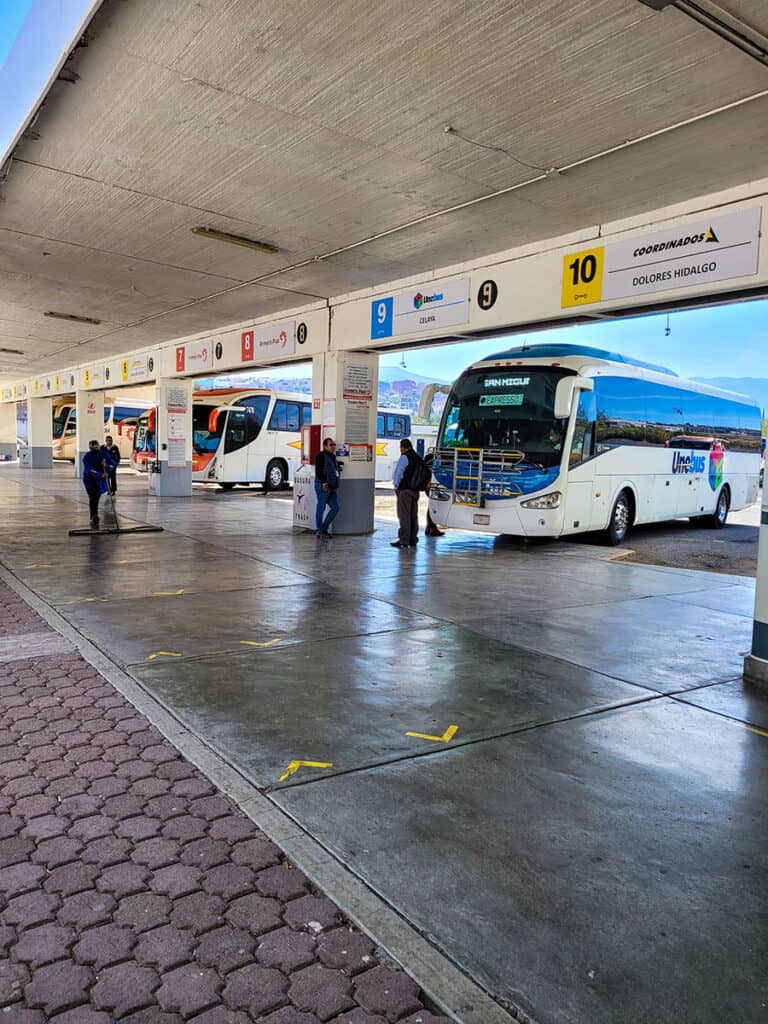
Bus platforms in the newer, larger bus stations are similar to gates at the airport. They may have glass doors that will remain closed until boarding, there will typically be seating and there may be some security features.
If you’re early and there’s not a lot of activity at the platform, this would be a good time to use the washroom or grab snacks and drinks. Just make sure you’re back in plenty of time to board.
Checking Your Bags
If you’re unfamiliar with bus travel in Mexico you may be surprised at how process-driven the system is. Unlike other parts of North America or Europe where your bags are just chucked into the cargo hold, things are a little more organized here.
Typically 15-30 minutes prior to the departure of your bus, baggage check will begin. This often happens at the same time as boarding.
During baggage check you will show the attendant your ticket and they will ask you how many bags you are checking. They will tag your bag (usually with your seat number) and then hand you the stub. Your bags will then be loaded into the cargo hold based on your destination.
When you arrive at your destination there will be a baggage attendant. Hand them your stub and they will retrieve your bags for you.
Boarding & Security
Boarding the bus in Mexico is not unlike at an airport. There will be an attendant or team of attendants, usually with a desk who will call the bus. Join the line and wait your turn.
When it’s your turn hand your ticket or show your electronic ticket to the attendant. They will confirm the information with you by repeating your destination and you can confirm back by saying Sí.
You should keep your ID handy in case they need to see it. This is not uncommon especially when travelling to and from Mexico City.
This is also a good time to confirm if everyone should be in their assigned seats by asking respeta el numero de asiento? Which means “do you respect the seat numbers?”
At some stations, often in major cities there may be security clearance as part of boarding. This typically a metal detector like at an airport. Pay attention to the staff as they will often wave foreigners through without stopping you.
Finding Your Seat & Settling In
Now that you’re on board you can settle in! Hopefully you sprung for a first class bus service and you’re in for a treat! Seat numbers are usually marked above the seat at eye level.
There will be an overhead compartment for carry-on luggage although I usually have enough room to keep my bag with me in my seat. If you decide to use the overhead compartment be sure to bring your valuables into your seat with you in case you fall asleep and someone goes shopping in your bags.

Now you can get comfy and log onto the WiFi, adjust your seat, fire up the in-seat entertainment, or whatever else your bus offers.
Mexico Bus Safety
Danger, or just the fear of it can easily ruin a trip. No one can truly enjoy themselves if they’re worried and can’t relax but of course, being aware of potential problems is just plain good sense.
So here are a few of the main ways that you can help set yourself up for a trouble-free bus journey in Mexico.
Only Take Direct Buses
I’m starting with this one because I think it’s really important and often overlooked.
Many people when they travel pay close attention to their spending and budget – which is fair enough! But sometimes it can push us to cut certain corners in order to save a couple of bucks.
One such corner that should never be cut is choosing a longer bus ride just to save some coins.
So why is this such a big deal? Well, you may have heard that in Mexico (much like most everywhere on earth), crime exists and a common criminal scheme is to rob bus passengers. The thing is though, it’s hard to rob a bus that won’t stop!
Many second class buses in Mexico will take long, meandering routes along their journey and can be flagged down at the side of the road. This means that anyone boarding the bus on the side of the road is exempt from the usual security measures that are implemented when boarding at a station.

This makes it an easy way for robbers to stop a bus load of people and take all the phones, valuables and money from the bus before taking off, never to be seen again.
The easiest way to avoid being a victim of this sort of crime is to take direct buses that only make scheduled stops at official stations. In other words, take first class buses in Mexico.
Don’t Be a Hero
Normally I don’t like talking danger in Mexico because I believe Mexico gets an unfairly bad rap when it comes to this sort of thing. But in this case I have some very sage advice that I think is important.
If you ever do find yourself as a victim of one of these bus bamboozles don’t be a hero. As painful as it is to hand over all your worldly goods to some undeserving bully, it’s not worth risking injury (or worse).
Remember, it’s just stuff and things are replaceable.
Do not try to hide valuables or try to trick them by only handing over some things. Just remain calm and hand it all over.
It’s a scary thing to consider and hopefully something you’ll never have to experience, but it’s important to know what to do if the time comes.
Pack Smart
Speaking of belongings, it’s important when taking buses in Mexico that you pack smart. Here are a few quick tips to help you pack the right way:

Have a Plan
When travelling by bus in Mexico, you should always have a plan. You should have considered and have answers to the following questions:
Planning ahead and having answers to these questions will help you navigate the bus system in Mexico with ease without feeling (and looking) too lost.
(Try To) Blend In
Speaking of looking lost, try to blend in! Sure, it might be hard to blend in when you’re visibly a foreigner carrying luggage, but I’m talking about blending into the way things are done.
I recently took a bus from the gorgeous town of San Miguel de Allende to Querétaro and while myself and about 15 other people were waiting quietly in a line for our bus a young woman burst onto the scene in a frenzy.
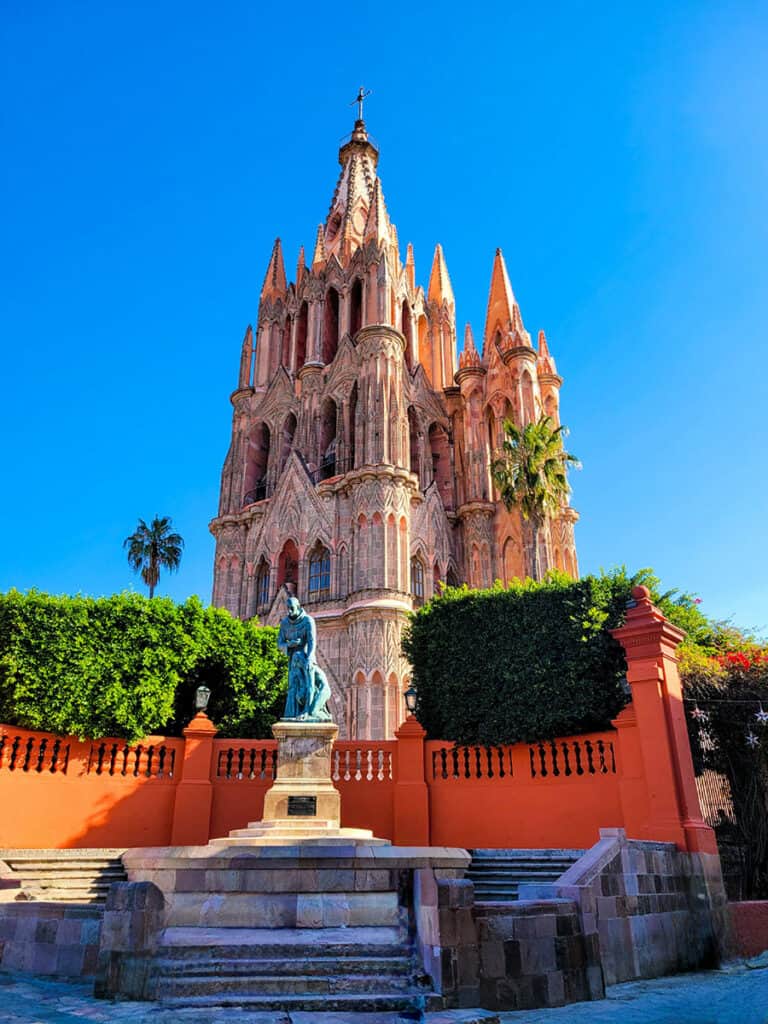
She was frantically yelling (in English) at the station employees, interrupting their conversation and attracting the attention of everyone in the quiet station.
For some reason public transportation sends some people into a panic!
Eventually, she calmed down and joined the back of our line and was a prime example of what not to do.
A great way to travel respectfully and blend in is to observe what the locals are doing. If people are speaking quietly, speak quietly. If people are walking on one side, walk on that side too. If people are waiting in line, join the line.
If you’re ever unsure of what to do you can absolutely approach members of staff and ask for help. Even if you don’t speak Spanish, show them your ticket and they’ll point you in the right direction. Just be sure to use your manners, wait your turn, and remain calm.
Making a scene or attracting unwanted attention is an easy way to put yourself on the radar of petty criminals and scammers. If you look like you know what you’re doing you are less of a target.
Be Aware
This safety tip is a bit of a given when it comes to travel, or life in general. Be aware. Be aware of yourself, your belongings, your surroundings and the people around you at all times.
Here are a few awareness tips to keep in mind when using buses and bus stations in Mexico:
These awareness and safety tips are not designed to frighten you. These are the same tips I would give to anyone visiting anywhere in the world.
It’s about setting yourself up for success and using street smarts to avoid the unfortunate happening.
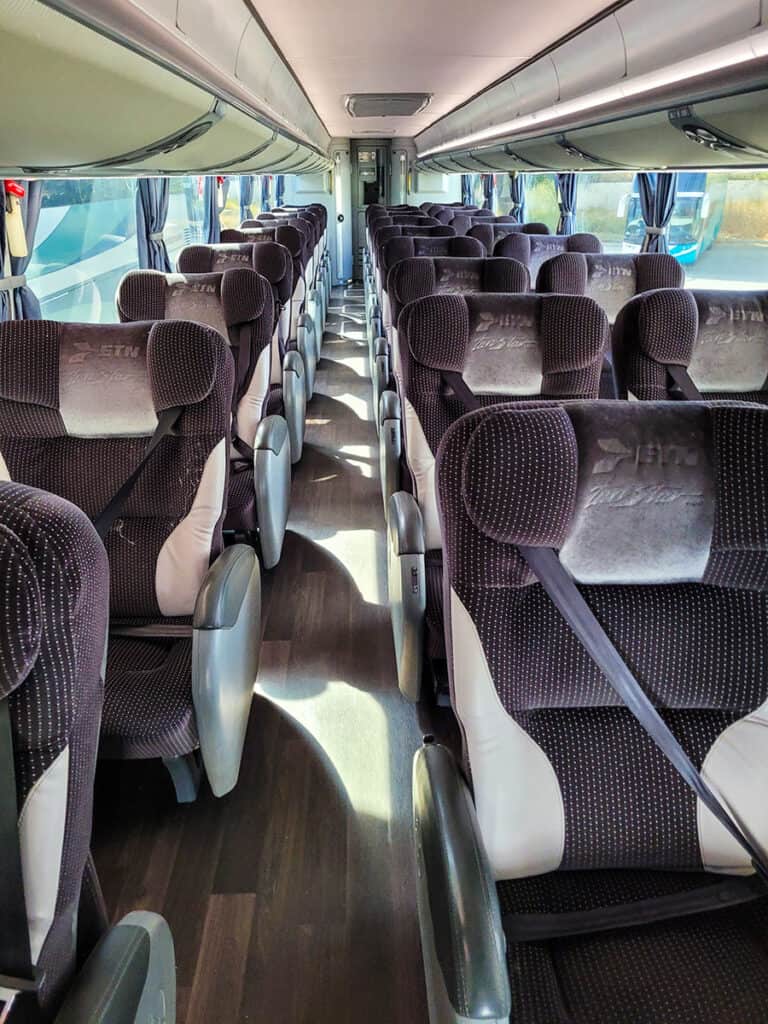
Useful Language For Mexico Bus Travel
If you haven’t already, grab my Free Useful Mexican Words & Phrases Cheatsheet at the bottom of this page. It’s full of really handy language you’ll need to navigate Mexico.
Here’s some other language you’ll likely need when taking the bus in Mexico:
Summary: Buses In Mexico
Hopefully I’ve convinced you by now that buses are a fantastic way to get around Mexico! First class buses in Mexico are the best buses I’ve ever travelled on anywhere in the world and they are unbelievably affordable for the quality of service provided.
Taking a bus in Mexico is a rite of passage and it doesn’t have to be scary. With a little preparation and knowledge of how the system works you’ll be falling in love with the experience like I did.
Using common sense along with the know-how, safety tips and useful phrases I’ve provided in this article you can navigate the buses of Mexico with confidence. Once you take your first trip I’m sure you’ll wonder why you didn’t do it sooner!

